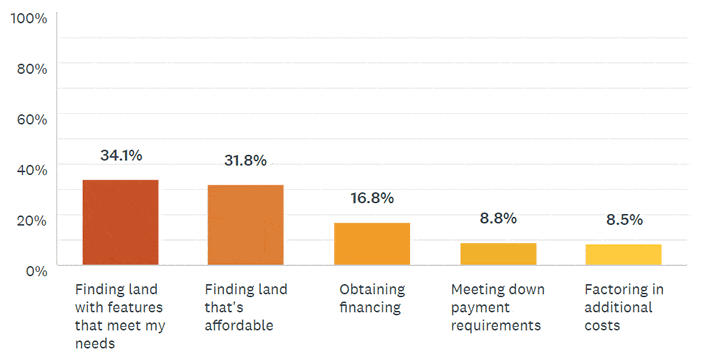The October LANDTHINK Pulse revealed that 34.1% of respondents said that finding land with features that meet their needs was the most challenging part of purchasing land. It’s a hot land market and properties are spending less and less time on the market. Based on the results of last month’s survey question, lagging supply might be stymieing many prospective buyers from finding their ideal piece of property. The central issue, mirrored nationwide according to land agents, is that there simply isn’t enough inventory to keep up with the demand. Land buyers can expect heavy competition; properties are selling fast, and when inventory is low, bidding wars heat up.
The October Pulse posed the following question to our LANDTHINK audience: What would you consider to be the most challenging part of purchasing land?
October Pulse Sponsored By
Finding the perfect piece of land that meets your needs and budget is often a challenge, even when there are plenty of properties on the market. However, when inventory is tight, the market favors the seller, who can afford to negotiate and wait patiently until the right offer comes their way. It stands to reason why, given the current state of the real estate land market, finding land with desired features and finding land that is affordable (31.8%) came in first and second respectively as the biggest challenges when making a land purchase.
This doesn’t mean buyers should get discouraged when setting out to find their dream property in a competitive market, but it does mean buyers and land agents must get creative. Buyers should discuss their needs, goals and expectations with a land agent who can help make sure they are prepared to make a competitive offer in a timely fashion when the right property does come along. Working with an agent who specializes in land will help buyers define their wants and their needs, help ensure they get a good deal and make their land transaction as smooth as possible. Creating a LANDFLIP Buyer Profile is another way buyers can find success in a low inventory market. Those searching for land can receive automatic emails when new listings matching their specified criteria come on the market.
In an article for LANDTHINK, United Country Real Estate urges buyers to remember that Flexibility is Key to a Successful Property Search. “Many buyers are dead-set at the beginning of their search that they have to have certain things, such as specific water sources, mature trees or flat topography. But often, all those wishes don’t fit into someone’s budget. So that’s the point in the buying process where flexibility needs to come into play.” The article explains how making adjustments to your land search can be quite simple if you approach the process with an open mind and they share a few things buyers should keep in mind.
The LANDTHINK audience certainly expressed mixed views on what they considered to be the most challenging part of purchasing land. The results of our informal online survey were all over the board, but the largest percentage (34.1%) indicated that locating land with features that met their needs was the hardest part of the land buying experience, followed closely by 31.8% of our audience, who indicated that finding land that was affordable was most difficult. Only 16.8% of respondents said that financing was the most challenging part of a land purchase. A mere 8.8% said meeting downpayment requirements, followed by 8.5% who said factoring in additional costs.

LANDTHINK often collaborates with a wide network of land industry experts to help us analyze and examine the current state of the real estate land market. We asked some of the top land experts for their perspective as to why the results of last month’s Pulse question indicated that buyers found it challenging to locate land with features their needs and was affordable.
Here’s what they had to say:
Jay Frazier, ALC, First Weber Realtors (WI): “Well, there is a shortage of inventory and if a parcel is nice and priced correctly, it sells pretty quickly. As a result, much of what’s left out there isn’t as desirable as buyers would like.” As to why buyers are having trouble finding land that is affordable, Jay added: “The market has been strong for a while and inventory is still somewhat low so as a result, sellers/agents are pricing many properties higher than what sold comps would dictate. Of course, that leads to a gap between list prices and what buyers feel is appropriate (based on sold comps).
Todd Crosby, Crosby Land Company (SC): “I think one of the biggest issues buyers have when trying to locate a property is finding one that meets their needs that is not overpriced. There are a lot of overpriced properties on the market, due to agents taking listings they should walk away from. Agents, for whatever reason, are inclined to let the seller dictate what the list price will be because it’s what they want, instead of educating the seller as to the real value of their asset based on factual data. As a result, there are a lot overpriced properties on the market and qualified buyers can’t find affordable properties that meet their needs. A good broker should have a knowledge of the property that he or she is selling and be able to help a seller understand the real market value of their property. I’ve turned down a lot of listings over the years because the seller wasn’t willing to listen to factual data. Maybe if other agents would do the same, buyers will be able to find quality tracts that are priced within what the market will bear.”
There has been a notable change in opinion as to what presents the biggest hurdle when purchasing land. In June 2012, the LANDTHINK Pulse revealed that the inability to obtain financing was the primary obstacle that prevented buyers from purchasing land. This month, only 16.8% indicated that the financing process presented a challenge when purchasing land, and only 8.8% said that meeting the down payment requirement might prove challenging when attempting to buy land.
The year 2006 was the peak of one of the worst housing bubbles in our lifetimes, if not ever. By 2007, the U.S. economy entered a mortgage crisis that caused panic and financial turmoil around the world. When we posed the following question to our audience back in 2012, “From your perspective, what is the primary obstacle that prevents a land buyer from purchasing land?”, the real estate market was beginning a long and slow slog to recovery.
America has come a long way since the government had to rescue the U.S. financial industry from collapsing, by passing the 2008 bailout bill. Over a decade later, we’re in a great period of nationwide prosperity. The current buoyant economy, low unemployment rates, job opportunities, rising incomes and continued faith in the real estate land market has created a strong demand for land. The overall state of the economy is a great predictor of what the future has in store for the rural land market. Right now, land is attractive to buyers, including large investors, who are in a position to purchase and take out a loan, feeling confident in the forecast of the overall economy and projected outlook for the real estate market. In the grand scheme of things, the low inventory problem is a pretty good problem to have.
LANDFLIP recently announced a strategic affiliation with Farm Credit institutions throughout the Southeast, whose network of customer-owned cooperatives support more than 500,000 farmers, ranchers, agricultural producers, rural infrastructure providers and rural homebuyers in all 50 states. We turned to the land financing experts for their insight on why financing has become easier for land buyers since we asked the question in 2012.
According to AgSouth Farm Credit Marketing Director Christy Smith, “The Farm Credit Associations have made a concerted effort to communicate and market that land financing is available in Georgia and South Carolina. Working with REALTORS® and networks like LANDTHINK and LANDFLIP, we have tremendously raised awareness that Farm Credit is the land lender. AgSouth, AgGeorgia, and Southwest Georgia Farm Credit Associations offer fixed-rate loans on land with as little as 15% down. Land Financing is what we do.”
Dewey Newton, Vice President of Corporate Lending for AgSouth Farm Credit, thinks one factor is well capitalized financial institutions. “Throughout the recession, banks lost liquidity through charge-offs. Lenders simple didn’t have capital reserves to suffer losses and grow at the same time. Financial institutions that survived have rebounded nicely and are back in the market actively seeking good lending opportunities.”
Land is usually bought with cash and a loan, with the buyer paying a decent amount of cash down and financing the remaining balance. Lenders have strict requirements in place for those seeking approval for a land loan, and borrowers can expect heftier down payments and scrutinization of their financial strength. Buyers should seek the help of a land agent, who will direct them to lending institutions who are familiar with financing rural land. Both will work closely with buyers and do the best they can to help buyers obtain financing for land.
Here are the final results of our audience, when asked what they consider to be the most challenging part of purchasing land:
- 34.1% said Finding land with features that meet my needs
- 31.8% said Finding land that’s affordable
- 16.8% said Obtaining financing
- 8.8%% said Meeting down payment requirements
- 8.5% said Factoring in additional costs
We were pleased with the large number of Pulse responses, and we thank everyone who answered the Pulse and shared it on social media with friends and connections in the land industry. LANDTHINK would like to extend a big thank you to Farm Credit Associations of Georgia for sponsoring the October Pulse and for coming up with a very interesting question to pose to our audience. When it comes to financing land, farms or homes, buyers have several options. Farm Credit Associations of Georgia offer advantages that aren’t available to buyers with other lenders. Their commitment and experience lending to agriculture and rural Georgia make the difference.
Become a Pulse sponsor! It’s a great way to ensure your brokerage is the first one buyers and sellers call when they have a need to buy or sell property. You’ll get insane exposure on Social + Email + Web. That’s 500,000+ monthly eyes on you! Once you have it, you won’t want to give it up! Pulse sponsorships are offered on a first come first serve basis and are subject to certain limitations. We’ve already secured a sponsor for December and January, but if your business would be interested in sponsoring the February Pulse, please contact us soon.
Do you have a suggestion for next month’s Pulse question? Submit your question and we might choose yours!
We want to know what you think about our November Pulse question, chosen and sponsored by American Forest Management: What are the 3 MOST IMPORTANT factors when selecting a real estate firm to assist you with buying or selling land? Answer now.
This content may not be used or reproduced in any manner whatsoever, in part or in whole, without written permission of LANDTHINK. Use of this content without permission is a violation of federal copyright law. The articles, posts, comments, opinions and information provided by LANDTHINK are for informational and research purposes only and DOES NOT substitute or coincide with the advice of an attorney, accountant, real estate broker or any other licensed real estate professional. LANDTHINK strongly advises visitors and readers to seek their own professional guidance and advice related to buying, investing in or selling real estate.











Topography, large trees, views and quality water sources are the big four hard attributes to a property. Fortunately people like us can provide important elements such as bodies of water, fish and wildlife habitat to most land.